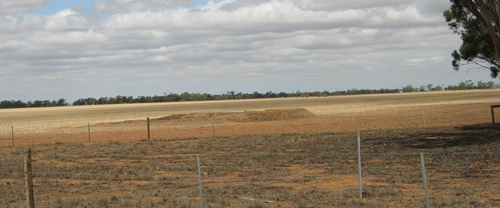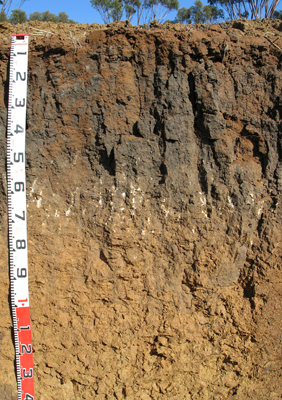LWA17
| Location: Birchip Cropping Group Main Field Day Site 2007 | |
| Australian Soil Classification: Vertic (& Calcic), Effervescent, Grey SODOSOL (thin clayey surface horizons) | |
| General Landscape Description: Level plain. | Site Description: Stubble paddock – main Birchip Cropping Group Field Day Site for 2007 |
| Geology: Quaternary aeolian and alluvial deposits | |
 LWA17 Landscape |
Soil Profile Morphology:
Surface Soil
| Ap | 0-10 cm | Dark brown (7.5YR3/3); heavy fine sandy clay loam to light clay; weak to very weak consistence (dry); soft surface condition; slightly calcareous; pH 8.3; sharp change to: |  LWA17 Profile |
| Subsoil | |||
| B21 | 10-40 cm | Dark grey (10YR4/1); heavy clay; moderate to strong coarse to very coarse (50- >100 mm) prismatic, parting to strong coarse to very coarse (20 - >50 mm) angular blocky structure; strong consistence (dry); very few (<2%) ferruginous nodules; some large slickensides at about 35 cm; soft and rough-faced peds; surface material has moved down ped faces; moderately calcareous; pH 9; clear change to: | |
| B22k | 40-70 cm | Dark greyish brown (10YR4/2) with diffuse reddish yellow (7.5YR6/6) mottles; heavy clay; moderate coarse (20-50 mm) blocky structure; strong consistence (dry); few (5%) soft and semi-hard calcareous segregations and some nodules (2-4 mm size), very few (2%) ferruginous nodules; highly calcareous; pH 9.4; gradual change to: | |
| B23 | 70-100 cm | Reddish yellow (7.5YR6/6) with diffuse pale yellow (2.5Y7/3) and reddish yellow (5YR6/6) mottles; heavy clay; strong, medium to coarse (10-50 mm), parting to moderate, fine (5-10 mm) lenticular structure; weak to firm consistence (moderately moist); highly calcareous; pH 9. | |
| B24 | 100-150+ cm | Reddish yellow (7.5YR6/6) with diffuse pale yellow (2.5Y7/3) and reddish yellow (5YR6/6) mottles; heavy clay; strong, medium to coarse (10-50 mm), parting to moderate, fine (5-10 mm) lenticular structure; weak to firm consistence (moderately moist); pH 9. | |
Key Profile Features:
Soil Profile Characteristics:
pH | Salinity Rating | |||
Surface (Ap horizon) | Moderately Alkaline | Very Low | Non-Sodic | None1 |
Subsoil (B21 horizon) | Strongly Alkaline | Low | Strongly Sodic | Slight2 |
Deeper subsoil (at 100-150+ cm) | Strongly Alkaline | High | Very Strongly Sodic | None3 |
- 1 Moderate dispersion after remoulding.
2 Complete dispersion after remoulding.
3 Lack of dispersion probably due to high level of soluble salts.
 |
Horizon | Horizon Depth | pH (water) | pH CaCl2 | EC 1:5 | NaCl | Org. Carbon mg/kg | Exchangeable Cations | |||
Ca | Mg | K | Na | |||||||
Meq/100g | ||||||||||
Ap | 0-10 | 8.3 | 7.7 | 0.15 | 0.99 | 19 | 4.1 | 1.6 | 1.2 | |
B21 | 10-40 | 9 | 8.2 | 0.37 | 0.02 | 0.52 | 21 | 9.2 | 1.1 | 6 |
B22k | 40-70 | 9.4 | 8.7 | 0.77 | 0.04 | 8 | 8.6 | 0.86 | 8.9 | |
B23 | 70-100 | 9.2 | 8.7 | 1.5 | 0.1 | 8.1 | 9.9 | 1.2 | 14 | |
B24 | 100-150+ | 9 | 8.6 | 2.1 | 0.17 | 9.4 | 13 | 1.4 | 17 | |
Horizon | Horizon Depth | Boron mg/kg | Field pF2.5 g/100g | Wilting Point pF4.2 g/100g | Coarse Sand (0.2-2.0mm) % | Fine Sand (0.02-0.2mm) % | Silt (0.002-0.02mm) % | Clay (<0.002mm) % |
Ap | 0-10 | 1.8 | 23.3 | 12.2 | 23 | 28 | 13 | 31 |
B21 | 10-40 | 3.5 | 41.7 | 21.6 | 18 | 18 | 8 | 52 |
B22k | 40-70 | 11 | 34.3 | 15.7 | 32 | 20 | 7 | 37 |
B23 | 70-100 | 18 | 42.6 | 21 | 18 | 15 | 8 | 50 |
B24 | 100-150+ | 29 | 51.7 | 27.5 | 8 | 11 | 14 | 59 |
Management Considerations:
Whole Profile
- In general, management strategies for all soils should aim to increase organic matter levels in the surface soil, minimise the degradation of soil aggregates and porosity, promote the development of stable biopores, improve the calcium status of the ion exchange complex (particularly when sodium is a significant part) and break up any hardpans. Less frequent tillage, using less aggressive implements and working the soil at optimum moisture conditions can all assist in maintaining soil aggregation and porosity, as well as, reducing the breakdown of organic matter.
- Surface (A) Horizon
- Tillage of clayey soils like these should be avoided if the soil is wet (i.e. wetter than the plastic limit). At such moisture conditions, excessive tillage, trafficking or over-stocking could result in some structural damage (e.g. compaction). Ideally, tillage should take place on clayey soils when the soil is drier than the plastic limit – down to at least the tillage depth.
- Some dispersion was noted in the field after the soil was remoulded which indicates that some structural degradation (e.g. surface sealing, crusting, increased cloddiness) may occur if the soil is cultivated or overstocked in a moist to wet condition. Also, raindrop impact on bare surface soil may also promote dispersion and result in surface sealing. Surface cover should be maintained to protect the soil against raindrop action. Management practices such as minimum tillage, stubble retention and pasture rotation can be used to improve organic matter levels.
Subsoil (B) Horizons
- The coarsely structured upper subsoil is strongly sodic and disperses completely after remoulding. This indicates that root and water movement will be significantly restricted in the subsoil.
- The subsoil is strongly alkaline throughout. This indicates that phosphorus and some trace elements such as iron, manganese, zinc and copper may be poorly available to plants and deficiencies may occur. Deficiencies can be determined by plant tissue analysis. Boron toxicity can also occur in strongly alkaline soils. Levels of boron measured in this pit site increase in the very strongly alkaline deeper subsoil (from 40 cm depth) to levels that may affect boron sensitive species. These include cereals, pulses and pasture legumes. Boron concentrations as low as 10 ppm, for example, can reduce lentil yield. Although there is limited data it is estimated that the threshold level of soluble boron for cereals is 15 mg/kg (Cartwright et al., 1984). Other work at Horsham DPI indicates that where there are low levels of soluble salts boron tolerance can be comparatively high, with little reduction in wheat yield at levels of up to 45 ppm (Quinlan, 2001).
- The level of soluble salts becomes high in the deeper subsoil (from 70 cm depth) which is likely to restrict the growth of deeper-rooted salt-sensitive species.
Note:
- Soil characterised by Mark Imhof Jan 07


